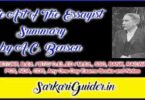Ode to Evening Summary by William Collins

Summary –
Ode to Evening appeared in “Odes on Several Descriptive and Allegorical Subjects” (1747). It is one of the finest lyrics of the 18th century. It is written in unrhymed stanzas of four lines.
The poem begins with an invocation to the Evening to teach the poet
to sing a soft strain to it. His song should be as soft as the murmur of the streams or the dying winds. The poet says that barring the cry of the bat and the beetle, there is complete calm all around in the evening. He wishes to go to some solitary and barren spot or some ancient ruined building among lonely valleys in the evening to watch its beauty, but if he is prevented from doing so by “chill, blustering winds or driving rain”, he would like to go to a lovely cottage on the mountain side to watch the dark coloured evening gradually descending over the surrounding landscape with the ‘gradual dusky veil”.
The poem ends with the poet’s conviction that the evening shall continue to inspire fancy (poets), friendship (friends), science (men of learning), and smiling peace (lovers of peace) throughout the seasons of the year.
Ode to Evening Summary in Hindi
साराँश-
‘ओड टु ईवनिंग’ नामक कविता सन् 1747 में प्रकाशित विलियम कालिन्स की रचना “विविध वर्णनात्मक और रूपकात्मक विषयों को समर्पित गीत” में संग्रहीत है। यह आठारहवीं शताब्दी के सर्वाधिक प्रसिद्ध गीतों में से एक है। यह चार-चार पंक्तियों के अनुकान्त छन्दों में लिखी गई है।
कवि उस सन्ध्या का अह्वान करता है जिसके विनीत कानों में प्रकृति के शान्त स्वर गुंजित होते हैं। सन्ध्या कभी पवित्र वेला और कभी समादूत परी या देवी के रूप में अवतरित होती है। सन्ध्या सूर्य को भी मानों छाया प्रदान करती है। सन्ध्याकाल में हवा शान्त होती है- परन्तु कहीं-कहीं कमजोर दृष्टि वाले चमगादड़ तथा अन्य जन्तु कुछ आवाज करते हैं। कवि ऐसी शान्त सन्ध्यादेवी से उसे भी कोई मन्द विलम्बित गीत सिखाने की याचना करता है। कवि इस कला को सीखकर सन्ध्या के वापस आने का गीत गायेगा। दिन में फूलों के भीतर सोती हुई परियाँ सन्ध्या के आने पर चाँद-तारों की रोशनी में जागकर सन्ध्या देवी का मानों छायादार रथ तैयार करती हैं। ऐसे समय में कवि सन्ध्या से आग्रह करता है कि वह उसे भी उस शान्त झील की ओर पीछे चलने का मार्ग दिखाये जहाँ उस झील के जल की चादर निर्जन स्थान को आनन्दपूर्ण बनाती है अथवा ऐसे स्थान पर ले चले जहाँ कोई प्राचीन इमारत की दीवाल प्रतिबिम्बित होकर धार्मिक भाव का सृजन करती हो। यदि ठंड के कारण उसके पैर आगे न बढ़ सकें तो वह किसी पहाड़ी झोपड़ी में विश्राम कर ले। संध्या की ओस-सिक्त अंगुलियाँ ऐसे समय में गूधूलि बेला के रूप में मानों कोई आवरण या पर्दा डाल देती है।
बसन्त सन्ध्या के बालों को संवारता है, ग्रीष्म शाम को देर तक बने रहने वाले प्रकाश में खेलता है, पतझड़ उसकी गोद को पत्तों से भर देता है और शिशिर अपनी बर्फीली हवाओं से उसके परिजनों को डरवाता है, परन्तु फिर भी सन्ध्या अपने सुखद छाया के नीचे पलने वाले कल्पना से कवियों, मैत्री भाव के जागरण से मित्रों को और विज्ञान-चिन्तन से विद्वज्जनों को प्रेरित करती है।
Important Links
Metaphysical Poetry: Definition, Characteristics and John Donne as a Metaphysical Poet
John Donne as a Metaphysical Poet
Shakespeare’s Sonnet 116: (explained in hindi)
What is poetry? What are its main characteristics?
Debate- Meaning, Advantage & Limitations of Debate
Sarojini Naidu (1879-1949) Biography, Quotes, & Poem Indian Weavers
Charles Mackay: Poems Sympathy, summary & Quotes – Biography
William Shakespeare – Quotes, Plays & Wife – Biography
Ralph Waldo Emerson – Poems, Quotes & Books- Biography
What is a lyric and what are its main forms?






